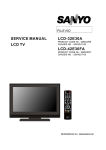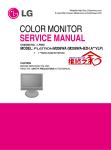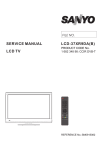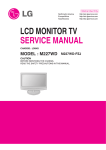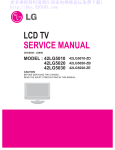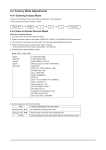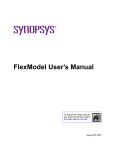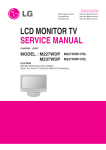Download LCD MONITOR TV SERVICE MANUAL
Transcript
Internal Use Only North/Latin America Europe/Africa Asia/Oceania http://aic.lgservice.com http://eic.lgservice.com http://biz.lgservice.com LCD MONITOR TV SERVICE MANUAL CHASSIS : LD84J MODEL : M237WD M237WD-PMJ CAUTION BEFORE SERVICING THE CHASSIS, READ THE SAFETY PRECAUTIONS IN THIS MANUAL. CONTENTS CONTENTS .............................................................................................. 2 PRECAUTIONS .........................................................................................3 SPECIFICATION ........................................................................................6 ADJUSTMENT INSTRUCTION ...............................................................12 TROUBLE SHOOTING ............................................................................15 BLOCK DIAGRAM...................................................................................24 DESCRIPION OF BLOCK DIAGRAM .....................................................25 EXPLODED VIEW .................................................................................. 26 SVC. SHEET ............................................................................................... Copyright C 2009 LG Electronics. Inc. All right reserved. Only for training and service purposes -2- LGE Internal Use Only SAFETY PRECAUTIONS IMPORTANT SAFETY NOTICE Many electrical and mechanical parts in this chassis have special safety-related characteristics. These parts are identified by in the Schematic Diagram and Exploded View. It is essential that these special safety parts should be replaced with the same components as recommended in this manual to prevent Shock, Fire, or other Hazards. Do not modify the original design without permission of manufacturer. Leakage Current Hot Check (See below Figure) Plug the AC cord directly into the AC outlet. General Guidance An isolation Transformer should always be used during the servicing of a receiver whose chassis is not isolated from the AC power line. Use a transformer of adequate power rating as this protects the technician from accidents resulting in personal injury from electrical shocks. It will also protect the receiver and it's components from being damaged by accidental shorts of the circuitry that may be inadvertently introduced during the service operation. If any fuse (or Fusible Resistor) in this TV receiver is blown, replace it with the specified. When replacing a high wattage resistor (Oxide Metal Film Resistor, over 1W), keep the resistor 10mm away from PCB. Do not use a line Isolation Transformer during this check. Connect 1.5K/10watt resistor in parallel with a 0.15uF capacitor between a known good earth ground (Water Pipe, Conduit, etc.) and the exposed metallic parts. Measure the AC voltage across the resistor using AC voltmeter with 1000 ohms/volt or more sensitivity. Reverse plug the AC cord into the AC outlet and repeat AC voltage measurements for each exposed metallic part. Any voltage measured must not exceed 0.75 volt RMS which is corresponds to 0.5mA. In case any measurement is out of the limits specified, there is possibility of shock hazard and the set must be checked and repaired before it is returned to the customer. Leakage Current Hot Check circuit Keep wires away from high voltage or high temperature parts. AC Volt-meter Before returning the receiver to the customer, always perform an AC leakage current check on the exposed metallic parts of the cabinet, such as antennas, terminals, etc., to be sure the set is safe to operate without damage of electrical shock. Leakage Current Cold Check(Antenna Cold Check) With the instrument AC plug removed from AC source, connect an electrical jumper across the two AC plug prongs. Place the AC switch in the on position, connect one lead of ohm-meter to the AC plug prongs tied together and touch other ohm-meter lead in turn to each exposed metallic parts such as antenna terminals, phone jacks, etc. If the exposed metallic part has a return path to the chassis, the measured resistance should be between 1MΩ and 5.2MΩ. When the exposed metal has no return path to the chassis the reading must be infinite. An other abnormality exists that must be corrected before the receiver is returned to the customer. Copyright C 2009 LG Electronics. Inc. All right reserved. Only for training and service purposes -3- To Instrument’s exposed METALLIC PARTS Good Earth Ground such as WATER PIPE, CONDUIT etc. 0.15uF 1.5 Kohm/10W When 25A is impressed between Earth and 2nd Ground for 1 second, Resistance must be less than 0.1 Ω *Base on Adjustment standard LGE Internal Use Only SERVICING PRECAUTIONS CAUTION: Before servicing receivers covered by this service manual and its supplements and addenda, read and follow the SAFETY PRECAUTIONS on page 3 of this publication. NOTE: If unforeseen circumstances create conflict between the following servicing precautions and any of the safety precautions on page 3 of this publication, always follow the safety precautions. Remember: Safety First. General Servicing Precautions 1. Always unplug the receiver AC power cord from the AC power source before; a. Removing or reinstalling any component, circuit board module or any other receiver assembly. b. Disconnecting or reconnecting any receiver electrical plug or other electrical connection. c. Connecting a test substitute in parallel with an electrolytic capacitor in the receiver. CAUTION: A wrong part substitution or incorrect polarity installation of electrolytic capacitors may result in an explosion hazard. 2. Test high voltage only by measuring it with an appropriate high voltage meter or other voltage measuring device (DVM, FETVOM, etc) equipped with a suitable high voltage probe. Do not test high voltage by "drawing an arc". 3. Do not spray chemicals on or near this receiver or any of its assemblies. 4. Unless specified otherwise in this service manual, clean electrical contacts only by applying the following mixture to the contacts with a pipe cleaner, cotton-tipped stick or comparable non-abrasive applicator; 10% (by volume) Acetone and 90% (by volume) isopropyl alcohol (90%-99% strength) CAUTION: This is a flammable mixture. Unless specified otherwise in this service manual, lubrication of contacts in not required. 5. Do not defeat any plug/socket B+ voltage interlocks with which receivers covered by this service manual might be equipped. 6. Do not apply AC power to this instrument and/or any of its electrical assemblies unless all solid-state device heat sinks are correctly installed. 7. Always connect the test receiver ground lead to the receiver chassis ground before connecting the test receiver positive lead. Always remove the test receiver ground lead last. 8. Use with this receiver only the test fixtures specified in this service manual. CAUTION: Do not connect the test fixture ground strap to any heat sink in this receiver. Electrostatically Sensitive (ES) Devices Some semiconductor (solid-state) devices can be damaged easily by static electricity. Such components commonly are called Electrostatically Sensitive (ES) Devices. Examples of typical ES devices are integrated circuits and some field-effect transistors and semiconductor "chip" components. The following techniques should be used to help reduce the incidence of component damage caused by static by static electricity. 1. Immediately before handling any semiconductor component or semiconductor-equipped assembly, drain off any electrostatic charge on your body by touching a known earth ground. Alternatively, obtain and wear a commercially available discharging wrist strap device, which should be removed to prevent potential shock reasons prior to applying power to the Copyright C 2009 LG Electronics. Inc. All right reserved. Only for training and service purposes unit under test. 2. After removing an electrical assembly equipped with ES devices, place the assembly on a conductive surface such as aluminum foil, to prevent electrostatic charge buildup or exposure of the assembly. 3. Use only a grounded-tip soldering iron to solder or unsolder ES devices. 4. Use only an anti-static type solder removal device. Some solder removal devices not classified as "anti-static" can generate electrical charges sufficient to damage ES devices. 5. Do not use freon-propelled chemicals. These can generate electrical charges sufficient to damage ES devices. 6. Do not remove a replacement ES device from its protective package until immediately before you are ready to install it. (Most replacement ES devices are packaged with leads electrically shorted together by conductive foam, aluminum foil or comparable conductive material). 7. Immediately before removing the protective material from the leads of a replacement ES device, touch the protective material to the chassis or circuit assembly into which the device will be installed. CAUTION: Be sure no power is applied to the chassis or circuit, and observe all other safety precautions. 8. Minimize bodily motions when handling unpackaged replacement ES devices. (Otherwise harmless motion such as the brushing together of your clothes fabric or the lifting of your foot from a carpeted floor can generate static electricity sufficient to damage an ES device.) General Soldering Guidelines 1. Use a grounded-tip, low-wattage soldering iron and appropriate tip size and shape that will maintain tip temperature within the range or 500ºF to 600ºF. 2. Use an appropriate gauge of RMA resin-core solder composed of 60 parts tin/40 parts lead. 3. Keep the soldering iron tip clean and well tinned. 4. Thoroughly clean the surfaces to be soldered. Use a mall wirebristle (0.5 inch, or 1.25cm) brush with a metal handle. Do not use freon-propelled spray-on cleaners. 5. Use the following unsoldering technique a. Allow the soldering iron tip to reach normal temperature. (500ºF to 600ºF) b. Heat the component lead until the solder melts. c. Quickly draw the melted solder with an anti-static, suctiontype solder removal device or with solder braid. CAUTION: Work quickly to avoid overheating the circuit board printed foil. 6. Use the following soldering technique. a. Allow the soldering iron tip to reach a normal temperature (500ºF to 600ºF) b. First, hold the soldering iron tip and solder the strand against the component lead until the solder melts. c. Quickly move the soldering iron tip to the junction of the component lead and the printed circuit foil, and hold it there only until the solder flows onto and around both the component lead and the foil. CAUTION: Work quickly to avoid overheating the circuit board printed foil. d. Closely inspect the solder area and remove any excess or splashed solder with a small wire-bristle brush. -4- LGE Internal Use Only IC Remove/Replacement Some chassis circuit boards have slotted holes (oblong) through which the IC leads are inserted and then bent flat against the circuit foil. When holes are the slotted type, the following technique should be used to remove and replace the IC. When working with boards using the familiar round hole, use the standard technique as outlined in paragraphs 5 and 6 above. Removal 1. Desolder and straighten each IC lead in one operation by gently prying up on the lead with the soldering iron tip as the solder melts. 2. Draw away the melted solder with an anti-static suction-type solder removal device (or with solder braid) before removing the IC. Replacement 1. Carefully insert the replacement IC in the circuit board. 2. Carefully bend each IC lead against the circuit foil pad and solder it. 3. Clean the soldered areas with a small wire-bristle brush. (It is not necessary to reapply acrylic coating to the areas). "Small-Signal" Discrete Transistor Removal/Replacement 1. Remove the defective transistor by clipping its leads as close as possible to the component body. 2. Bend into a "U" shape the end of each of three leads remaining on the circuit board. 3. Bend into a "U" shape the replacement transistor leads. 4. Connect the replacement transistor leads to the corresponding leads extending from the circuit board and crimp the "U" with long nose pliers to insure metal to metal contact then solder each connection. Power Output, Transistor Device Removal/Replacement 1. Heat and remove all solder from around the transistor leads. 2. Remove the heat sink mounting screw (if so equipped). 3. Carefully remove the transistor from the heat sink of the circuit board. 4. Insert new transistor in the circuit board. 5. Solder each transistor lead, and clip off excess lead. 6. Replace heat sink. Circuit Board Foil Repair Excessive heat applied to the copper foil of any printed circuit board will weaken the adhesive that bonds the foil to the circuit board causing the foil to separate from or "lift-off" the board. The following guidelines and procedures should be followed whenever this condition is encountered. At IC Connections To repair a defective copper pattern at IC connections use the following procedure to install a jumper wire on the copper pattern side of the circuit board. (Use this technique only on IC connections). 1. Carefully remove the damaged copper pattern with a sharp knife. (Remove only as much copper as absolutely necessary). 2. carefully scratch away the solder resist and acrylic coating (if used) from the end of the remaining copper pattern. 3. Bend a small "U" in one end of a small gauge jumper wire and carefully crimp it around the IC pin. Solder the IC connection. 4. Route the jumper wire along the path of the out-away copper pattern and let it overlap the previously scraped end of the good copper pattern. Solder the overlapped area and clip off any excess jumper wire. At Other Connections Use the following technique to repair the defective copper pattern at connections other than IC Pins. This technique involves the installation of a jumper wire on the component side of the circuit board. 1. Remove the defective copper pattern with a sharp knife. Remove at least 1/4 inch of copper, to ensure that a hazardous condition will not exist if the jumper wire opens. 2. Trace along the copper pattern from both sides of the pattern break and locate the nearest component that is directly connected to the affected copper pattern. 3. Connect insulated 20-gauge jumper wire from the lead of the nearest component on one side of the pattern break to the lead of the nearest component on the other side. Carefully crimp and solder the connections. CAUTION: Be sure the insulated jumper wire is dressed so the it does not touch components or sharp edges. Diode Removal/Replacement 1. Remove defective diode by clipping its leads as close as possible to diode body. 2. Bend the two remaining leads perpendicular y to the circuit board. 3. Observing diode polarity, wrap each lead of the new diode around the corresponding lead on the circuit board. 4. Securely crimp each connection and solder it. 5. Inspect (on the circuit board copper side) the solder joints of the two "original" leads. If they are not shiny, reheat them and if necessary, apply additional solder. Fuse and Conventional Resistor Removal/Replacement 1. Clip each fuse or resistor lead at top of the circuit board hollow stake. 2. Securely crimp the leads of replacement component around notch at stake top. 3. Solder the connections. CAUTION: Maintain original spacing between the replaced component and adjacent components and the circuit board to prevent excessive component temperatures. Copyright C 2009 LG Electronics. Inc. All right reserved. Only for training and service purposes -5- LGE Internal Use Only SPECIFICATION NOTE : Specifications and others are subject to change without notice for improvement. 1. Application Range. 3.Test method 1) This spec sheet is applied all of the LCD TV with LD84J chassis. 2) Not included spec and each product spec in this spec sheet apply correspondingly to the following each country standard and requirement of Buyer 3.1 Performance : LGE TV test method followed 3.2 Demanded other specification - Safety : UL,CSA,IEC specification - EMC : FCC,ICES,IEC specification 2. Specification Each part is tested as below without special appointment 1. Temperature : 20±5°C 2. Relative Humidity : 65±10% 3. Power Voltage : Standard input voltage (100~240V@50/60Hz) *Standard Voltage of each product is marked by models 2.4 Specification and performance of each parts are followed each drawing and specification by part number in accordance with BOM. 2.5 The receiver must be operated for about 20 minutes prior to the adjustment. 4. General Specification 4.1 PC No Item Specification 1 Supported Sync. Type Separate Sync., Digital 2 Operating Frequency Analog Horizontal 30 ~ 83kHz Vertical 56 ~ 75 Hz Horizontal 30 ~ 83kHz Vertical 56 ~ 75 Hz Analog Max. 1920x1080 @ 60Hz Recommand 1920x1080 @ 60Hz Digital Max. 1920x1080 @ 60Hz Digital 3 Resolution Remarks Recommand Cold Start : 50 A 1920x1080 @ 60Hz 4 Inrush Current 5 Operating Condition Sync (H/V) Video LED Wattage Power S/W On On mode On/On Active Blue 55W (Max) On/On Active Blue 45W (Typ) Sleep mode Off/On On/Off Power S/W Off Off mode - Hot : 120 A Off Amber 1W Off Off 1W 6 MTBF 50,000 HRS with 90% Confidence level 7 Using Altitude 5,000 m (for Reliability) 3,000m(for FOS) Copyright C 2009 LG Electronics. Inc. All right reserved. Only for training and service purposes -6- Lamp Life 40,000 Hours (Min) LGE Internal Use Only 4.2 TV No Item Specification 1. Receiving System ATSC/64 &256 QAM/NTSC-M 2. Available Channel 1)VHF :02~13 Remarks USA ONLY 2)UHF :14~69 3)DTV :02-69 4)CATV :01~135 5)CADTV :01~135 3. Input Voltage 1)AC 100 ~ 240V 50/60Hz 4. Market North America 5. Screen Size 23 inch Wide(23.00 inch) 6. Aspect Ratio 16:9 7. LCD Module LM230WF1-TLA1(1920 x1080) 8. Operating Environment 1)Temp :0 ~40 deg Non-Glare,Wide,LPL TN 2)Humidity :~80 % 9. Storage Environment 1)Temp :-20 ~60 deg 2)Humidity :0 ~90 % 5. Optical characteristic specification 5.1 Chroma &Brightness. No. 1. 2. Specification Item Viewing Angle<CR>10> Luminance Remark Min typ Right/Left 70/70 85/85 Up/Down 60/70 75/85 25 0 300 Luminance Max DVI or RGB (cd/m2) - Stnadard, 6500K - Full White (100IRE) Variance(%) 3. Contrast Ratio 4. Color Coordinates 75 CR 600 White [CIE 1931] 1000 Wx Wy 0.329 RED Rx Green Gy 0.614 Bx 0.146 Blue Full White/ Full black 0.313 Typ 0.644 Typ Ry 0.336 -0.03 Gx 0.295 DVI or RGB - Stnadard, 6500K - Full White (100IRE) By 0.072 * Optical Test Condition - Surrounding Brightness Level : dark - Surrounding Temperature : 25 ± 5°C - warm-up Time : 30 Min - Contrast, Brightness : Outgoing condition - *Incase of Vivid Mode, high level saturation may be occurred.Check gray linearity at standard mode. * Active area - Active area of LCD PANEL is in bezel of cabinet. - Interval between active area and bezel | A-B|<1.0 mm , | C-D|<1.0 mm A: Interval between left of active area and bezel B: Interval between right of active area and bezel C: Interval between top of active area and bezel D: Interval between bottom of active area and bezel Copyright C 2009 LG Electronics. Inc. All right reserved. Only for training and service purposes C Active Area B A D -7- Bezel LGE Internal Use Only 5.2 Chroma (PSM :PC Mode-Standard, AV Mode-Vivid) ** The W/B Tolerance is ±0.002 for Adjustment, but for DQA ±0.015 No 1. 2. 3. 4. 5. Item Min Typ Max Remark Cool Wx 0.283 0.285 0.287 AV Mode (9300K) Wy 0.291 0.293 0.295 - RF/ AV1,2,3/ Component/ HDMI Medium Wx 0.293 0.295 0.297 - Vivid (8000K) Wy 0.203 0.305 0.307 - Cool/ Medium/ Warm: 85IRE Warm Wx 0.311 0.313 0.315 (6500K) Wy 0.327 0.329 0.331 6500k Wx 0.283 0.313 0.343 PC Mode Wy 0.299 0.329 0.359 - RGB/ DVI Wx 0.253 0.283 0.313 - Stnadard Wy 0.268 0.298 0.328 - 6500K/ 9300K :Full White 100IRE 9300k *The spec range of Color coordinates is same with the one of module,because this model does not adjust white balance. 6. SET Optical Feature 6.1 PC Mode (Measurement Condition:Full white/Standard/6500k)-> Measure the black luminance after 30 seconds. No 1 Luminance(cd/m2) Item 23 inch Min Typ 250 300 C/R Max Remark Min Typ 600:1 1000:1 DFC 30,000:1 6.2 AV Mode (Measurement Condition:Full white(100IRE)/Vivid)-> Measure the black luminance after 30 seconds. No Item 1 23 inch Luminance(cd/m2) Min Typ 170 220 C/R(Min) Max Remark RF,AV,COMPONENT,HDMI 400:1 6.3 Dynamic CR - Dynamic CR Working Condition : Full Black Pattern( All Black, No pattern( MSPG Pattern# 2)) signal in D- sub & DVI No Item Min Typ 1 M237WD-PMJ 24000: 1 30000: 1 Max Remark For Checking Black Luminance, wait for over 1 minute. 7. Mechanical specification No 1 Item Content Product Width(W) Dimension Before Packing 560.8 After Packing 651 2 Product Only SET 3 Cintaniner Quantity 4 Stand Assy 193.2 427 mm 456 161 mm Kg 7.4 Kg 20ft Individual or Palletizing Type Remark Height(H) 5.6 With BOX Loding Unit Length(L) 40ft Indi. Wooden Indi. Wooden 630 520 1260 1144 Detachable Size (W x D x H) 271.2 x 193.2 x 108.4 5 Appearance Tilt Degree -5~15degree Tilt force 0.8~3.5kgf General Refer to Standard of LG(56)G1-1020 Copyright C 2009 LG Electronics. Inc. All right reserved. Only for training and service purposes -8- LGE Internal Use Only 8. Component Video Input (Y, PB, PR) No. Specification Resolution H-freq(kHz) V-freq(Hz) Remark 1. 720* 480 15.73 59.94 SDTV ,DVD 480I 2. 720* 480 15.73 60.00 SDTV ,DVD 480I 3. 720* 480 31.47 59.94 SDTV 480P 4. 720* 480 31.50 60.00 SDTV 480P 5. 1280* 720 44.96 59.94 HDTV 720P 6. 1280* 720 45.00 60.00 HDTV 720P 7. 1920* 1080 33.72 59.94 HDTV 1080I 8. 1920* 1080 33.75 60.00 HDTV 1080I 9. 1920* 1080 23.0 24.0 HDTV 1080P 10. 1920* 1080 33.75 30 HDTV 1080P 11. 1920* 1080 67.43 59.94 HDTV 1080P 12. 1920* 1080 67.5 60 HDTV 1080P 10. RGB/DVI 10.1 Input ( PC ) No. Resolution H-freq(kHz) V-freq(Hz) Pixel clock(MHz) 1 720*400 31.468 70.08 28.321 2 640*480 31.469 59.94 25.175 Remark Input 848x480 60Hz, 852x480 60Hz -> 640x480 60Hz Display 3 640*480 37.5 75 31.5 4 800*600 37.879 60.317 40.0 5 800*600 46.875 75.0 49.5 6 1024*768 48.363 60.0 65.0 7 1024*768 60.123 75.029 78.75 8 1152* 864 67.500 75.000 108.0 9 1280* 1024 63.981 60.02 108.0 10 1280* 1024 79.976 75.035 135.0 11 1680* 1050 64.674 59.883 119.0 12 1680* 1050 65.290 59.954 1 46.25 13 1600* 1200 75.0 60.0 162.0 14 1920* 1080 66.587 59.934 138.5 10.3 RGB EDID Data - Analog EDID_Product ID :22251 Copyright C 2009 LG Electronics. Inc. All right reserved. Only for training and service purposes -9- LGE Internal Use Only - DVI(Digital)EDID_Product ID :22252 - Adjustable Data : *: Serial No. .( Input the S/ N at Total Assembly line) **: week ***: year ex) when year 2006 : input “10” **** : CHECK SUM (deferent along Serial No, week, year) 12. HDMI1,2 12.1 Input ( DTV: For Video, PC is not Supported) No. Resolution H-freq(kHz) V-freq(Hz) Pixel clock(MHz) Remark 1 720* 480 31.469 / 31.5 59.94 / 60 23.00/ 23.03 SDTV 480P 2 720* 576 31.25 50 54 SDTV 576P 3 1280* 720 37.500 50 74.25 HDTV 720P 4 1280* 720 44.96 / 45 59.94 / 60 74.17/ 74.25 HDTV 720P 5 1920* 1080 33.72 / 33.75 59.94 / 60 74.17/ 74.25 HDTV 1080I 6 1920* 1080 28.125 50.00 74.25 HDTV 1080I 7 1920* 1080 26.97 / 23 23.97 / 24 74.17/ 74.25 HDTV 1080P 8 1920* 1080 33.716 / 33.75 29.976 / 30.00 74.25 HDTV 1080P 9 1920* 1080 56.250 50 148.5 HDTV 1080P 10 1920* 1080 67.43 / 67.5 59.94 / 60 148.35/ 148.50 HDTV 1080P Copyright C 2009 LG Electronics. Inc. All right reserved. Only for training and service purposes - 10 - LGE Internal Use Only 11.2 EDID Data - HDMI EDID - Product ID : 22253 ( HDMI1 and HDMI2 have the Same EDID) 1) HDMI1 2) HDMI2 1) All data are HEXA 2) Adjustable Data : *: Serial No. **: week ***: year ex) when year 2008 : input “12” **** : CHECK SUM (deferent along Serial No, week, year) Copyright C 2009 LG Electronics. Inc. All right reserved. Only for training and service purposes - 11 - LGE Internal Use Only ADJUSTMENT INSTRUCTION 5. Click "Auto" tab and set as below 6. Click "Run". 7. After downloading, check "OK" message. 1. Application 1) This spec sheet is applied all of the LCD TV with LD84J chassis. 2)Not included spec and each product spec in this spec sheet apply correspondingly to the following each country standard and requirement of Buyer (6) filexxx.bin (7) .OK 2. Designation 1) The adjustment is according to the order which is designated and which must be followed, according to the plan which can be changed only on agreeing. 2) Power Adjustment: Free Voltage 3) Magnetic Field Condition: Nil. 4) Input signal Unit: Product Specification Standard 5) Reserve after operation: Above 30 Minutes 6) Adjustment equipments: Color Analyzer( CA- 210 or CA110), Pattern Generator ( MSPG- 925L or Equivalent ), DDC Adjustment Jig equipment, SVC remote controller (5) 3.1 ADC Process 3. Main PCB check process # APC - After Manual-Insult, executing APC # Download 1. Execute ISP program "Mstar ISP Utility" and then click "Config" tab. 2. Set as below, and then click "Auto Detect" and check "OK" message. If display "Error", Check connect computer, jig, and set. 3. Click "Connect" tab. If display "Can’t ", Check connect computer, jig, and set. (1) (2) 3.1.1 PC input ADC 3.1.1.1 Auto RGB Gain/Offset Adjustment • Convert to PC in Input-source I2C COMMAND: 0xF4(SELECT_INPUT)0x00 0x60 (RGB) cf. 0x10(TV),0x20(AV),0x40(COMPONENT),0x60(RGB), 0x90(HDMI) • Signal equipment displays Output Voltage : 700 mVp-p Impress Resolution XGA (1024 x 768 @ 60Hz) Model: 60 in Pattern Generator Pattern: 29 in Pattern Generator (MSPG-925 SERISE) [gray pattern that left & right is black and center is white signal (Refer below picture)]. (3) OK 4. Click "Read" tab, and then load download file(XXXX.bin) by clicking "Read" (4) filexxx.bin Copyright C 2009 LG Electronics. Inc. All right reserved. Only for training and service purposes - 12 - Adjustment pattern (PC ) • Adjust by commanding AUTO_COLOR_ADJUST(0xF1) 0x00 0x02 instruction. 3.1.1.2 Confirmation • We confirm whether “0xB6(RGB)” address of EEPROM “0xA2” is “0xAA”or not. • If “0xB6(RGB)” address of EEPROM “0xB2” isn’t “0xAA”, we adjust once more • We can confirm the ADC values from “0xB0~ 0xB5(RGB)” addresses in a page “0xA2” *Manual ADC process using Service Remocon. After enter Service Mode by pushing “INSTART” key, execute “AutoRGB” by pushing “ ” key at “Auto-RGB”. LGE Internal Use Only 3.2.1COMPONENT input ADC 3.2.1.1Component Gain/Offset Adjustment • Convert to Component in Input-source I2C COMMAND :0xF4(SELECT_INPUT)0x00 0x40 (COMPONENT) cf.0x10(TV),0x20(AV),0x40(COMPONENT), 0x60(RGB),0x90(HDMI) • Signal equipment displays at SD Mode Impress Resolution: 480i MODEL :209in Pattern Generator(SD Mode) PATTERN :08in Pattern Generator(MSPG-925 SERISE) • Signal equipment displays at HD Mode Impress Resolution:1080i MODEL :223in Pattern Generator(HD Mode) PATTERN :08in Pattern Generator(MSPG-925 SERISE) 4. Total Assembly line process Adjustment pattern (COMPONENT ) • Adjust by commanding AUTO_COLOR_ADJUST(0xF1) 0x00 0x02 instruction 3.2.1.2 Confirmation • We confirm whether “0xC8(1080i)”address of EEPROM “0xA2” is “0xAA” or not. • If “0xC8(1080i)” address of EEPROM “0xA2” isn’t “0xAA”, we adjust once more • We can confirm the ADC values from “0xC2~(1080i)” addresses in a page “0xA2” 3.2 Function Check 3.2.1 Check display and sound • Check Input and Signal items. ( cf. work instructions) 1.TV 2.AV (CVBS/ S-Video) 3.COMPONENT (1080i) 4.RGB (PC: 1680X1050 @60Hz) 5.HDMI 6.PC Audio In and H/P Out * Display and Sound check is executed by Remote controller. Copyright C 2009 LG Electronics. Inc. All right reserved. Only for training and service purposes - 13 - 4.1 Adjustment Preparation • Above 30 minutes H/run in RF no signal • 15 Pin D-Sub Connector, for IIIC communication not including VGA signal,is connected to AUTO W/B EQUIPMENT.. 4.2 Check coordinate of 9300K •Set Input mode to RGB. • Set Temperature : 9300K • Adjust x: 0.285±0.005, y: 0.293±0.005(9300°K ) (Full white MSPG series Pattern 4) 4.3 Check color coordinate of 6500K • Set Input mode to RGB. • Set Temperature : 6500K • Adjust x:0.313±0.005, y:0.329±0.005(6500°K ) (Full white MSPG series Pattern 4) 4.4 DPM operation confirmation (Only Apply for MNT Model) Check if Power LED Color and Power Consumption operate as standard. • Set Input to RGB and connect D-sub cable to set • Measurement Condition : (100~240V@50/60Hz) • Confirm DPM operation at the state of screen without Signal 4.5 DDC EDID Write Model Name(M237WD-PMJ): • Connect D- sub Signal Cable to D-Sub Jack. • Connect DVI Signal Cable to DVI Jack. • Connect HDMI1,2 Signal Cable to HDMI1,2 Jack. • Write EDID DATA to EEPROM(24C02) by using DDC2B protocol. • Check whether written EDID data is correct or not. (refer to Product spec). 4.6 HDCP (High-Bandwidth Digital Contents Protection)SETTING • Connect D-sub Signal Cable to D-Sub Jack • Input HDCP key with HDCP-key-in-program • HDCP Key value is stored on EEPROM(AT24C512) which is 80~A1 addresses of 0xA0~0xA2 page • AC off/on and on HDCP button of MSPG925 and confirm whether picture is displayed or not of using MSPG925 • HDCP Key value is different among the sets. 4.7 Outgoing condition Configuration • After all function test., press IN-STOP Key by SVC Remote controller. And Make Ship Condition. • When pressing IN-STOP key by SVC remocon, Red LED are blinked alternatively. And then Automatically turn off. (Must not AC power OFF during blinking) 4.8 Internal pressure • Confirm whether is normal or not when between power board's ac block and GND is impacked on 1.5kV(dc) or 2.2kV(dc) for one second LGE Internal Use Only 5.3 E2PROM Data Write 5. Adjustment Command 5.3.1 Signal Table 5.1 Adjustment Commands(LEMGTH=84) START No. Adjustment Contents CMD ADR VAL Description 1 FACTORY ON E0 00 00 Factory mode on 2 FACTORY OFF E2 00 00 Factory mode off 3 EEPROM ALL INIT. E4 00 00 EEPROM All c lear 4 EEPROM Read E7 00 00 EEPROM Read 5 EEPROM Write E8 00 Data EEPROM Write by so me values 6 COLOR SAVE (R/G/B cutoff) EB Drive, Contrast, Bright) 00 00 Color Save 7 H POSITION 20 00 00~100 8 V POSITION 30 00 00~100 9 CLOCK 90 00 00~100 10 PHASE 92 00 00~100 11 R DRIVE 16 00 00~FF 12 G DRIVE 18 00 00~FF They have different range B DRIVE 1A 00 00~FF 80 00 00~7F 15 G CUTOFF 82 00 00~7F 16 B CUTOFF 84 00 00~7F 17 BRIGHT 10 00 00~3F 19 CONTRAST 12 00 00~64 20 AUTO_COLOR_ ADJU ST F1 00 02 21 CHANGE_COLOR_TEMP F2 00 0: COOL 0,1,2,3 1: NORMAL 2: WARM 3: USER 23 F4 AUTO_INPUTCHANGE 00 00 A 03 Data_n A CMD A ADH A A CS A ADL A STOP CMD(hex) LEN Details 1 EEPROM WRITE E8 94 16-Byte Write 84+n n-byte Write - use • EDID write : 16-byte by 16-byte, 8 order (128-byte) write(TO “00 – 7F” of “EEPROM Page A4”) • FOS Default write : 16-mode data (HFh,HFl,VF,STD,HP,VP,Clk,ClkPh,PhFine) write • Random Data write : write the appointment Address of E2PROM Offset adjustment Bright adjustment Luminance adjustment 5.4 VRAM Read • Send CMD(70h) to read Video RAM value from MICOM And save its value to 128-Bytes Buffer(Common Buffer for the use of EDID) START 6E A Factory mode off & II_SW is 1 & Input change to TV 0,1,2,4 ... Adjustment contents Auto COLOR Adjustment 00 A 84+n No. Drive adjustment R CUTOFF F3 50 A 2 14 FACTORY_DEFAULT A LEN : 84h + Byte CMD : 8Eh ADH : E2PROM Slave Address (A0, A2, A4, A8), Not 00h (Reserved by Buffer to E2PROM ) ADL : E2PROM Sub Address ( 00~ FF) Data : Write data 5.3.2 Command Set mode, FOS Adjustment 13 22 6E Data_1 50 A 84 A 03 A 70 A 00 A 00 A CS A STOP 3 : Component • Delay 500ms ( Time to Wait and Read Video RAM from MICOM) • Be transmitted the contents of MICOM’s 128-bytes Buffer to PC. (128th Data is the CheckSum of 127-bytes data : That’s OK if the value of adding 128-bytes Data is Zero) 4 : RGB START 5 : DVI 6 : HDMI 0 : 1 : TV AV1 2 : AV2 6F A Data1 ... Data128 A CS NA STOP 5.2 EEPROM DATA READ 5.2.1 Signal Table START 6E A 50 A 84 CS A STOP START 6F A D1 A ---------------------------------------------------------------------- Dn A STOP A 03 A CMD A ADH A ADL A 128 Bytes 5.2.2 Command Set No. 1 Adjustment contents EEPROM READ CMD A DH E7 A0 2 3 A2 8 0 80 A4 6 7 0 80 4 5 ADL 0 80 A6 0 80 Details 0-Page 0~7F Read 0-Page 80~FF Read 1-Page 0~7F Read 1-Page 80~FF Read 2-Page 0~7F Read 2-Page 80~FF Read 3-Page 0~7F Read 3-Page 80~FF Read *use: To read the appointment Address of E Copyright C 2009 LG Electronics. Inc. All right reserved. Only for training and service purposes - 14 - LGE Internal Use Only TROUBLESHOOTING 1. Power- Up Boot Fail Trouble Shooting Check P700 All Voltage Level (5V, 15V) N Check Pow er con nector OK ? N Replace Po wer board Y Check Q702 Outp ut Voltage Level (5V) N Replace Q702 Y Check IC705 #2 Pin Voltage Level 3.3V N Replace IC 705 & Recheck Y Check X101 Clock 12MHz N Replace X 101 Y Replace IC 106 Flash Memory Wave form of X101 Copyright C 2009 LG Electronics. Inc. All right reserved. Only for training and service purposes - 15 - LGE Internal Use Only 2. No OSD Trouble Shooting Check P70 0(#9) INV_ON high N Check GPIO Path (Refer to Appe ndix 1 .) Y 1. Check Po wer Board , 15V 2. Check Q702 Output voltage(5V) 3. Check P302(#1, 2, 3) 5V N 1. Replace Pow er Board 2. Replace Q702 Y Check P30 2 #8(TXEC+) , #9(TXEC-) , #20(TXOC+) , #21(TXOC-) N IC101 has problem Y Check L VDS Cable for damage or ope n con ductors . Y Replace Ca ble N Check L CD Module Control board (Refer to Module CAS) Copyright C 2009 LG Electronics. Inc. All right reserved. Only for training and service purposes - 16 - LGE Internal Use Only 3. Digital TV Video Trouble Shooting Check RF Ca ble Y Check Tu ner 5V Po wer & Q707 5V N Replace Q7 07 Y Bad Tun er. Replace Tuner. Check L D400 color None Check T P Clock, Data, Sync R440, R441, R442 Yello w -> none N Maybe Tun er(TU400) has problems Y Check Demod ulator Input Clock X400 (25MHz) N Replace X400 Y Check IC10 1 LVDS output #8(TXEC+) , #9(TXEC-) , #20(TXOC+) , #21(TXOC-) N Replace IC101 has problems Y Check L CD Module Control board Refer to Mo dule CAS Wave form of X400 Copyright C 2009 LG Electronics. Inc. All right reserved. Only for training and service purposes - 17 - LGE Internal Use Only 4. Component Video Trouble Shooting Check inpu t signal for mat Is it supported? Y Check Compo nent Cab le Y N Replace JK602 or Che ck Divice Check J K602 Y Check signal C124, C126, C129 N Check R10 7, R109, R112, C124, C126, C129 Y IC101 has problem Wave form of Comp Y Wave form of Comp Pb Wave form of C124 Copyright C 2009 LG Electronics. Inc. All right reserved. Only for training and service purposes Wave form of C126 - 18 - Wave form of Comp Pr Wave form of C129 LGE Internal Use Only 5. RGB Video Trouble Shooting Check inpu t signal format Is it supported? Y Check RGB Cable connector for damage Y N Replace JK607 Check JK607 Y Check signal , Hsync, Vsync (R673, R674) N Replace R6 73, R674 Y Check signal RGB (R119, R104, R105 C121,C122,C119) N Replace R119, R104, R105, C121,C122,C119 Y IC101 has problem Wave form of R673(Vsync) Wave form of R105/C122 Copyright C 2009 LG Electronics. Inc. All right reserved. Only for training and service purposes Wave form of R104/C121 - 19 - Wave form of R673(Vsync) Wave form of R119/C119 LGE Internal Use Only 6. AV Video Trouble Shooting Check inpu t signal for mat Is it supported? Y Check AV Ca ble / S-Video Cable f or damage or ope n conn ector Y Check signal R611(AV_CVBS), R625, R626(S_Video) N Replace R6 11, R625, R626 Y Check signal RGB R116, R113, R114 C137, C134, C135 N Replace R1 16, R113, R114 C137, C134, C135 Y IC101 has problem Wave form of R611(CVBS) Wave form of R625(S-video) Copyright C 2009 LG Electronics. Inc. All right reserved. Only for training and service purposes - 20 - Wave form of R626(S-video) LGE Internal Use Only 7.HDMI Video Trouble Shooting Check input signal form at Is it supported? Y Check HD MI Cable for damage o r open conn ecto r Y Check JK801 / JK802 for proper connectio n or dam age N Replace c onn ector Y Check IC803 Out Volta ge Level 3.3V(Pin 6) N Replace IC803 Y Check ED ID NVRAM (IC801, IC802) Power & I2 C Sig nal (#5, #6) Y N Check HD CP Key NVRAM (IC105) Power & I2 C Sig nal (#5, #6) N Redownloa d EDID data or Rep ace IC801/IC802 l Replace IC105 Y Replace Ms tar (IC101) Copyright C 2009 LG Electronics. Inc. All right reserved. Only for training and service purposes - 21 - LGE Internal Use Only 8. All Source Audio Trouble Shooting Make sure yo u can t hear any audi o and Device sup port the au di o sig nal norm ally . Y Check Speaker and it s w ire con nectio n (P500) An d the resistance N Replace co nnector or Speaker Y Check 15V From Po wer board (P700, Pin #1,2) An d Check Aud io Amp Pow er 12V (IC501, Pin#2, 3, 3 4, 35, 40, 41, 44, 45) N Replace P ower Board or Check L511 Y Check Sig nal from IC501 L502, L503, L504, L505 N Replace IC 500 Y Check Sig nal from IC101 (R130, R131, R1021, R1022) Copyright C 2009 LG Electronics. Inc. All right reserved. Only for training and service purposes N - 22 - Replace IC 101 LGE Internal Use Only Appendix 1. GPIO Path. Copyright C 2009 LG Electronics. Inc. All right reserved. Only for training and service purposes - 23 - LGE Internal Use Only Copyright C 2009 LG Electronics. Inc. All right reserved. Only for training and service purposes - 24 - RS232C RF COMP S-VIDEO AV SCART(Full) PC_Audio RGB (PC Only) DVI-D (PC Only) HDMI1, 2 (DTV Only) MAX3232CDR RX / TX IC700 COMP_LR_IN COMP_ YPbPr S-VIDEO_DET CVBS_LR_IN S-VIDEO_YC_IN CVBS_IN TV_VOUT TV_LR_OUT/ RXD / TXD TV_MAIN/MAIN_SIF IIC_TUNER AMP GAIN X 4 LGE6991DD MSTAR DDR I2S REG 3.3V 2.5V MP2305 MP2305 DC-DC DC-DC REG 3.3V TAS5709 Digital AMP EARPHONE AMP TPA6110 15V LCD (LVDS) MX25L1605 AM2C-15G 24C64 EEPROM +5V SWITCH DUAL FET PSU SPK 2CH 5V_ST SPI_D PANEL_CTL/POWER_ON/OFF +1.25V_ST +5V_TUNER INV_CTL/ DIMMING SW_RESET / IIC_AMP EAR_LR_OUT/MUTE IIC_PART SPI_CZ/CLK HYB25DC256163CE-4 LVA[0:3] / LVB[0:3] / LVACLK/ LVBCLK MDATA[0:15] MADR[0:11] TMDS/DDC/ HDMI_SEL/HDMI_IIC HDMI S/W TMDS351PAG RGB/HVS/IIC_DSUB DDC SC_VIN/ID1/FB/RGB SCART_LRIN PC_AUD 24C02BN EEPROM HDMI3_5V_DET(HPD) HDMI 1,2 TMDS/DDC/HPD_S/W DDC 24C02BN 24C02BN EEPROM 24C02BN EEPROM EEPROM PANEL_POWER BLOCK DIAGRAM LGE Internal Use Only DESCRIPTION OF BLOCK DIAGRAM 1.Input Interface. 1-1.PC Input - RGB Input is directly transmitted to LGE1854C(scaler,Clock 12Mhz) and display up to 1920*1080 resolution - DVI Signal input go to scaler through TMSD351(DVI/HDMI Switch) - PC Audio is connected PC-Audio input by Stereo Cable 1-2 Video Input - Component :YPbPr/YCbCr signal input, Up to 1080P Resolution. - CVBS/S-Video : CVBS/S-Video signal input, supporting 480P - HDMI 1,2 :Digital signal input(Included Audio) 1-3 RF(ATSC/NTSC)Input :ATSC/NTSC Input. 1-4 Audio Input :Component L/R,Audio L/R,Stereo(For PC) input. 2.Output Interface - Video :The video signal goes to LGE1854C(Scaler)-> Frame Memory(210MHz:converted LVDS signal)->Module - Audio :The audio is divided Digital signal at Scaler go through NTP3000A(Audio Amp IC) and generate to Speaker Head-phone signal is divided to stereo signal at Scaler, then generate Headphone Amp(IC TPA6110) - Optical Output :Generate audio output from Scaler(SPDIF(Optical) 3.Power Interface - Input 5V,15V from Power Board is converted to 3.3V,2.6V,1.8V,1.25V,1.2V by Regulator and DC/DC Converter Supply power to Module,Audio Amp and IC Copyright C 2009 LG Electronics. Inc. All right reserved. Only for training and service purposes - 25 - LGE Internal Use Only EXPLODED VIEW IMPORTANT SAFETY NOTICE 300 510 520 500 200 120 810 530 540 910 800 900 400 Many electrical and mechanical parts in this chassis have special safety-related characteristics. These parts are identified by in the Schematic Diagram and EXPLODED VIEW. It is essential that these special safety parts should be replaced with the same components as recommended in this manual to prevent X-RADIATION, Shock, Fire, or other Hazards. Do not modify the original design without permission of manufacturer. Copyright LG Electronics. Inc. All right reserved. Only for training and service purposes - 26 - LGE Internal Use Only SCHEMATIC DIAGRAM MAIN Copyright C 2008 LG Electronics. Inc. All right reserved. Only for training and service purposes - 27 - LGE Internal Use Only DDR Copyright C 2008 LG Electronics. Inc. All right reserved. Only for training and service purposes - 28 - LGE Internal Use Only TUNER/ DEMODULELATOR Copyright C 2008 LG Electronics. Inc. All right reserved. Only for training and service purposes - 29 - LGE Internal Use Only LVDS/ CONTROL Copyright C 2008 LG Electronics. Inc. All right reserved. Only for training and service purposes - 30 - LGE Internal Use Only INTERFACE Copyright C 2008 LG Electronics. Inc. All right reserved. Only for training and service purposes - 31 - LGE Internal Use Only POWER Copyright C 2008 LG Electronics. Inc. All right reserved. Only for training and service purposes - 32 - LGE Internal Use Only HDMI / DVI Copyright C 2008 LG Electronics. Inc. All right reserved. Only for training and service purposes - 33 - LGE Internal Use Only AMP Copyright C 2008 LG Electronics. Inc. All right reserved. Only for training and service purposes - 34 - LGE Internal Use Only LED_IR_HP Copyright C 2008 LG Electronics. Inc. All right reserved. Only for training and service purposes - 35 - LGE Internal Use Only CONTROL KEY Copyright C 2008 LG Electronics. Inc. All right reserved. Only for training and service purposes - 36 - LGE Internal Use Only P/NO : MFL49414510 Jan., 2009 Printed in Korea





































